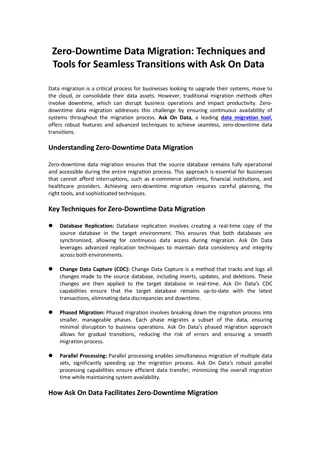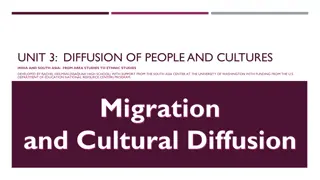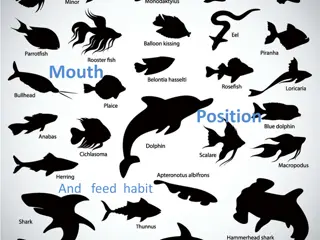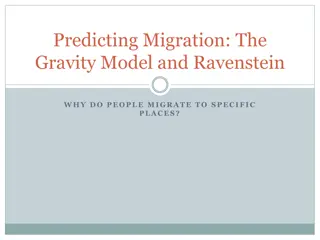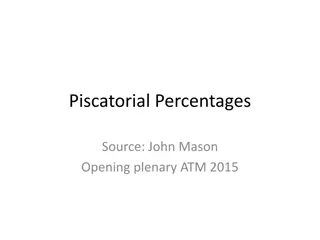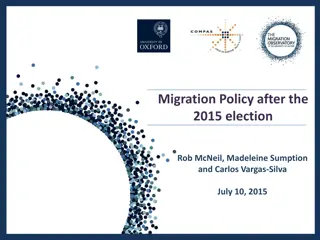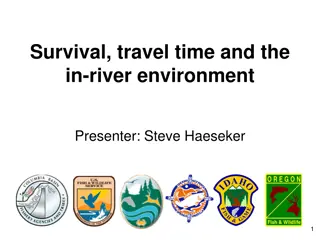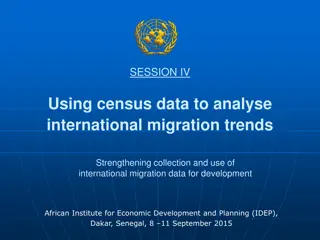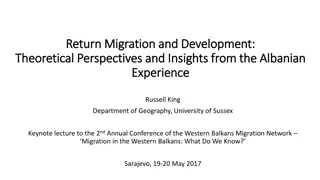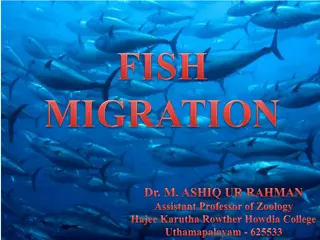Understanding Fish Migration Patterns and Behaviors
Fish migration involves the movement of aquatic animals for various purposes such as feeding, reproduction, and habitat changes. This article explores different types of fish migration, including shoaling, schooling, and various migration patterns based on habitat changes. From freshwater to marine habitats, fish exhibit fascinating behaviors and adaptations to survive and thrive in changing environments.
Download Presentation

Please find below an Image/Link to download the presentation.
The content on the website is provided AS IS for your information and personal use only. It may not be sold, licensed, or shared on other websites without obtaining consent from the author. Download presentation by click this link. If you encounter any issues during the download, it is possible that the publisher has removed the file from their server.
E N D
Presentation Transcript
Basic Terms Migration is the movement of large number of animals from one place to another for feeding, reproduction or to escape weather extremes. Shoaling:- When large no. of fishes come together and move socially, it is called as shoaling, Eg. Tuna, Anchovies. Schooling:-Migrating fishes exhibit high degree of coordination in their movements and carry out synchronized maneuvers to produce different types of shapes. This is called schooling.eg. Forage fishes
Fishes live in two different types of aquatic habitats:- 1.Freshwater Habitat 2.Marine Habitat
On the basis of cause, fish migration is of following types : Feeding or alimental migration:- It takes place in fishes for feeding. Examples:- Salmons, cods and sword fish migrate for food. Spawning migration :- It takes place in breeding season in those fishes which have spawning grounds far away from the feeding places. Examples:- Eels, salmons and a large no. of riverine fishes. Juvenile migration:- It involves larval stages of fishes which hatch in spawning grounds and migrate long distances to reach the feeding habits of their parents. Recruitment migration:- It takes place when large no. of larvae move from nursery habitat to the habitat of adults. Seasonal migration:- It takes place in fishes that inhabit arctic areas where in summer climate is conducive and food abundant but as winter approaches temperature fall below zero and food becomes scarce. Hence, fishes must migrate towards subtropical and tropical areas to escape extremes of weather conditions.
FISH MIGRATION ON THE BASIS OF HABITAT CHANGE POTAMODROMOUS OCEANODROMOUS DIADROMOUS CATADROMOUS FROM FRESH WATER TO SEA WATER ANADROMOUS FROM SEA WATER TO FRESH WATER
Different types of fish migration on the basis of habitat: Potamodromous Migration:-When fishes migrate from one freshwater habitat to another in search of food or spawning, it is called as potamodromous migration. Fishes also migrate to lay eggs in places where oxygen concentration in water is more and where there is abundance of food for juveniles when they hatch from eggs. Example:- Common Asian Carps
Oceanodromous Migration:- This migration is from sea water to sea water. Example:-There are about 12,000 marine species that regularly migrate within sea like herrings, sardines, mackerels, cods, roaches and tunas. Diadromous migration:- When fishes can migrate from fresh water to sea water or from sea water to fresh water, it is called diadromous migration. It involves 120 species of fishes that are capable of overcoming osmotic barriers and migrate in these habitats.
Catadromous Migration:- This type of migration involves movement of large number of fishes from fresh water to sea water, generally for spawning as happens in the case of Anguilla(eels). Before migration the following changes take place in their bodies: They deposit large amount of fat in their bodies which serves as reserve food during the long journey. Color changes from yellow to metallic silvery grey. Digestive tract shrinks and feeding stops. Eyes are enlarged and vision sharpens. Other sensory organs also become sensitive. Skin becomes respiratory. Gonads get matured and enlarged. They become restless and develop strong urge to migrate in groups.
Anadromous Migration:- It involves migration of fishes from sea water to fresh water. Example:- Salmon and trout To maintain homeostasis, freshwater species have special adaptations for retaining ions and getting rid of excess water. 1. They actively take in ions across their gills and skin, a process that requires energy. 2. To get rid of excess water they excrete nitrogenous waste products in great quantities in the form of highly diluted urine.
DIADROMOUS MIGRATION Anadromous Migration Catadromous Migration
Oceanodromous fish migrating area Catadromous Fish Migrating area Potamodromous fish migrating area Anadromous fish migrating area
Vertical Migration The movement of fishes towards upper surface of sea during night and towards bottom during day fro various endogenous and exogenous reasons is called vertical migration. Diet vertical migration is a common behavior; many marine species move to the surface at night to feed and then return to the depths during daytime. Factors playing role in Vertical Migration:- 1. Endogenous factors:- which originate from organism itself like sex, age biological rhythms, etc. 2. Exogenous factors:- These are the environment factors acting on the organisms such as light, gravity, oxygen, temperature, predator-prey interactions etc.
Significance of Vertical Migration Predator Avoidance:- Organisms come up to shallow waters at night to feed while it s dark out because their predators cannot see them as easily as in day. Metabolic Advantage:-By feeding in the warm surface waters at night and residing in the cooler deep waters during the day they can conserve energy. Alternatively, organisms feeding on the bottom in cold water during the day may migrate to surface waters at night in order to digest their meal at warmer temperatures. Dispersal and Transport:- Organisms can use deep and shallow currents to find food patches or to maintain a geographical location. Avoid UV Damage:-The sunlight can penetrate into the water column. If an organism, especially something small like a microbe, is too close to the surface , the UV can actually damage them. So they want to avoid getting too close to the surface, especially during daylight. Better Opportunities for Growth and Reproduction.
Other important facts Forage fish (prey fish) are small fish which are preyed upon by large predators for food. They migrate in schooling manner. Their schools become immense shoals which are concentrated fuel resources for the great marine predators.
Significance of fish migration Spawning To achieve better growth rates Greater reproductive success Temporal and spatial aggregations of fishes. To escape temperature extremes.
Need to understand fish migratory behavior Migration makes fish more vulnerable to exploitation(fishing). This is clearly of significance for commercial fisheries, and fisheries have traditionally exploited this migratory and aggregating behavior in salmon and cod.



